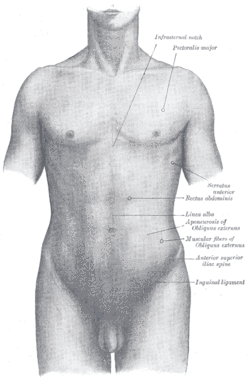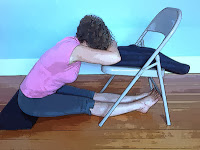by Shari
I assumed a few general recommendation concerning how you can care your hips healthy and happy could be useful for each ladies and males alike.
I recommend you begin by discovering your hips and assessing your mobility. I typically inquire my students to start by finding their hip joints. They're not on the exterior of your respective pelvis however the actual place exactly in which whenever you raise your legs up when you're climbing stairs, you are feeling the actual muscle moving below your fingers. This is actually the head of your respective femur (thigh bone).
 |
| Hip Joint is located approx. behind Inguinal Ligament |
Subsequent, check your own personal level of leg external and internal rotation. Lie on the ground in Savasana (Corpse pose), along with your feet somewhat apart. Then, moving from the hips whilst keeping your legs directly, flip your legs out thus the shape of your toes flip far from one another. This really is external rotation. As you are doing this motion, ensure you are performing the actual motion from the hips not from the lower leg/knee. Notice how far you are able to flip your legs out, and regardless of whether each side are a similar. Subsequent, moving from the hips whilst keeping your legs directly, flip your legs in thus the shape of your toes are turning towards one another. This really is internal rotation. Once more, as you are doing this during exercise, be certain the motion originates from the hips not from the lower leg/knee. Notice how far you are able to flip your legs in, and regardless of whether each side are a similar.
Once you are able to feeling how a lot actual hip rotation you even have (and if you are a similar on each side), you can start to assess your own personal foot placements for standing poses. Begin by exploring your specific hip alignment in wide-legged, side-facing standing poses, for example Warrior 2 or Triangle pose. Notice be it easier to really truly come to sense your hip place in case you stage within your standing pose from Mountain pose (Tadasana) by stepping back again along with your still remaining leg and keeping your correct leg stable, instead of stepping the ideal leg forward and also the still remaining leg back again (the standard Iyengar yoga cue). Then, while you consider your stance inside the pose, first attempt keeping your front heel in line along with your back again middle arch and notice how the back again leg internal rotation feels. If you happen to find which in an effort to try this alignment you need to reposition your lower leg moving from the knee to correct this alignment, attempt a wider front heel to back again heel stance and find out if the feels such as less tension with your knees and back again hip.
I remind my students not to square the actual pelvis however to enable the actual front pelvis to become inside the same plane like the front knee and the rear knee to become inside the same plane as the rear pelvis. In these kinds of poses, your front leg will certainly be in external rotation relative within your back again leg, and that is in internal rotation. Whilst operating along with your hips, don’t forget your knee positioning—to safeguard your knees, please align your knee along with the center of your respective ankle joint and usually in line along with your second toe. These joints ought to be lined up. Correct alignment that's optimum for you personally may consider a few experimentation, whenever in you’re doubt, make use of a mirror to assist you verify precisely that path your knees and hips are facing.
Continue this exploration altogether your wide-legged standing poses, for example Extended Aspect Hand pose and Warrior 1. Attempt to not force rotation by inflicting your pelvis to maneuver greater than is comfy more than your stable legs. And don’t be scared to line your front heel along with your back again heel should that provides you a lot of a way of freedom with your hip joints ! Turning one joint surface an excessive amount in relationship to an additional (the actual femur turning inside the cup from the acetabula) can place stress and strain upon the hip joint capsule and also the ligaments which maintain the actual hip inside the socket from the acetabula.
A few guidelines of thumb for standing poses :
- Any pain inside the groin or knees should be revered. Please back again from the place.
- Spend focus on pain in any physique component, most especially when performing one leg positions (balancing poses) and check out to modify to prevent reproducing your pain. It is basically crucial to understand how to use your muscles (that got to contract on each side from the joints) and bones to aid your weight instead of depending upon the ligamentous structures within the joints to supply stability. Pain can derive from compressing your pain sensitive structures within joints (ligaments, tendons and capsules) or from moving beyond the actual joints limits of mobility
- Attempt to prevent overly stretching the actual front of your respective thighs near your hip crease with your back again leg in poses such as Warrior 1, Triangle pose, and so on. As well as for lunges, prevent heading within your finish vary along with your back again leg and “hanging out” there.
Currently on to seated poses ! If you are sitting inside a directly leg place such as Staff pose (Dandasana) or inside a bent leg place such as Seated Crossed Legs (Sukasana), Cobbler’s pose (Baddha Konasana) or Lotus/Half Lotus, it's very crucial to sit along with your knees beneath your hips. When you have limitations with your hip external rotation, you certainly got to sit on a prop (folded blankets or bolster). And in case you can’t raise your pelvis up during the front of your respective hip joints (this'll seem like a slumped place), once more pleased sit on a prop to enable a few area so that you could lengthen up and convey your spine back again into the natural neutral curves.
 |
| Sitting on a Prop |
Keep in mind the actual spine has curves for any reason—they function a suggests that to distribute weight with the spine down the vertebral bodies. In case you sit inside a reversed or slumped place, you affect the weight-bearing forces on your facet joints and also the soft tissue structures of the rear (muscles and ligaments and discs). Whenever you sit along with your bones providing the actual assistance, you'll tire less and breath much better !
Finally, in bent leg positions, you'll would like to aid your outer legs to avoid the actual sensation of hip pain. You are able to location folded blankets or blocks below your knees to care your legs from hanging in area.
Sitting in Hero pose (Virasana) is a special hip position—internal rotation. Depending upon the somewhat of internal rotation which you've, it might or might not be potential that you can sit along with your knees along. During this case, attempt sitting on a better assistance thus your pelvis could be during the heads of your respective femurs (thigh bones) not at the rear of all of these, and permit your knees to separate although not roll out. Align your thighs along with your hip joints. Attempt palpating your hips in Hero pose and experiment to discover in case changing how shut along your knees are helps in order to make the actual pose a lot of comfy. Reclined Hero pose (Supta Virasana) is likewise a special hip place as a result of internal rotation is currently superimposed having a backbend and in case your hips can’t transfer into internal rotation, then your lumbar spine and sacrum can attempt to compensate for the shortage of motion which could additionally lead to pain and discomfort. This really is particularly the actual case for ladies as a result of our sacroiliac joints might not lock down in weight bearing during this backbend thus there could be a an uneven distribution of weight in the rear bend place. Learning how you can prop for each Hero pose and Reclined Hero pose is basically necessary, and maybe you would like a teacher to assist you with one of these alignment problems.
The actual bony structure and joint orientation of your respective hips inside the acetabulum from the pelvis are variables which can't be modified. Bones is allowed to transfer in sure methods because of type and purpose. We may attempt to compensate for our particular immobility by excessively overusing our soft tissue ligaments and joint capsules to attempt to gain flexibility that many of us lack. Or, we may inadvertently attempt in order to make our hips transfer beyond their anatomical prospects from the sports activities that many of us perform as well as yoga that many of us apply as a result of we expect the aim is much more flexibility. This certainly can lead to excessive wear and tear from the hip joint top to cartilage deterioration and arthritis. Thus the difficulty very is our perception of exactly what a pose is supposed to seem such as. The way in which a pose feels is extremely individualistic, and it isn't great to struggle having a pose which constantly leads to pain. Typically for some people sure poses aren’t attainable inside the classical feeling, however I think that in case we will recreate the actual really truly come to sense from the pose we will obtain the advantages. For instance, Dancer’s pose (Natarajasana) is really a challenging balancing backbend during which you raise one bent leg at the rear of you and achieve overhead along with one bent arm to carry the actual toes of your respective raised foot. But, modifying this pose by reaching your directly arm back again to carry your foot rather than up overhead will allow recreate the actual beauty and focus from the classical pose.
For healthy aging, I think which struggle might not continually be the simplest way to go ; rather, learning to become less aggressive and a lot of adaptive is really a very greatest method to approach asana. Mental concentrate and alertness along with focus on by using the breath to make asana is much more satisfying than attempting to force yourself into contortions which might not be potential for one’s innate physical structure. This really is how we balance and safeguard ourselves from injury throughout the physical asana apply.